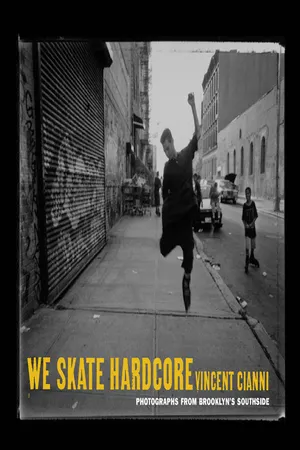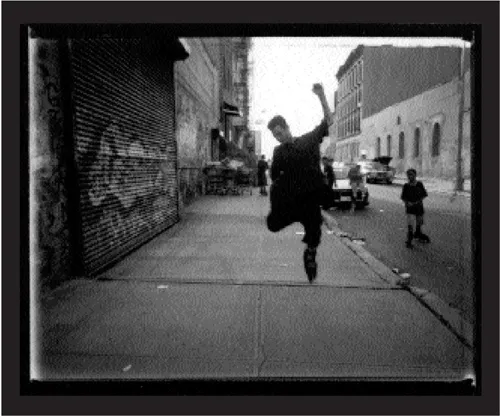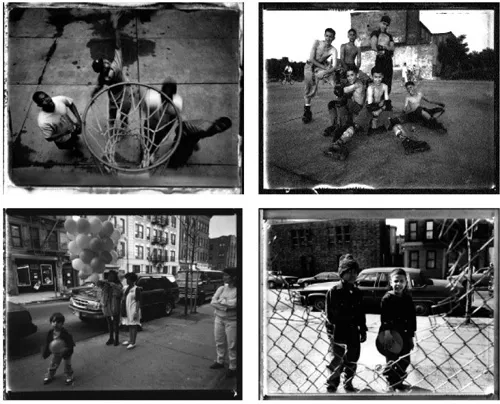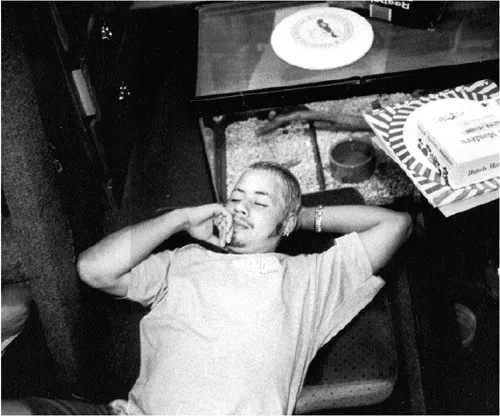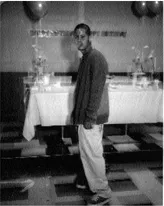![]()
INTRODUCTION
VINCENT CIANNI
In 1992 I moved to a loft in the Greenpoint section of Brooklyn, New York. That year, on my way home from work, I often passed by the Southside in Williamsburg to stop at Hector’s tacqueria on Bedford Avenue near Grand Street. I was enamored by the vitality, sounds, and smells of the streets in the Latino neighborhood. By November 1993 I had found a place to live and work just around the corner from Hector’s. I hired Beto, whose mother owned the video store across the street, and his friend Angel to help me carry furniture up to my second-floor loft in a former warehouse building. For the first year I concentrated on fixing up the raw space. Hector’s, the bakery, and the corner bodega, on the other end of the block, became central to my daily life and the focus of my attempts to speak more Spanish.
During a warm break in the weather in the fall of 1994 I began going to McCarren Park, drawn by the neighborhood activities and games played on the park’s soccer and baseball fields, on its track and handball courts. The park is the largest in the neighborhood, some three blocks of open green space bustling with energy. Young men smash handballs against cement walls, kick soccer balls with the grace of dancers and strength of weightlifters, and hit and catch baseballs with intense determination, wearing uniforms of their own design. Families gather on weekends to picnic and barbecue, particularly on holidays and Puerto Rican day celebrations. The shrieks and yells for outstanding plays or defeated attempts as well as salsa music permeate the air, mixing with the smell of cuchifrito or rice and beans. I began making portraits of teenagers playing ball in McCarren and the other parks, in schoolyards, and on the streets and sidewalks of the Southside.
The Southside’s boundaries create a neighborhood of seven square blocks with distinct borders—the East River to the west, the Brooklyn-Queens Expressway (BQE) to the east, and Metropolitan Avenue and Broadway to the north and south, respectively. Built by Robert Moses in 1954, the BQE effectively cut the neighborhood in two. The Williamsburg Bridge, spanning the East River, connects the Southside to Manhattan’s Lower East Side. During the 1990s, the Bridge was, like the neighborhoods around it, gritty and often dangerous, until renovations were completed in 2002. Over the years Williamsburg’s waterfront has decayed, leaving behind underutilized and abandoned industrial buildings that were once the sources of the neighborhood’s wealth and culture
Inside the Southside, life unfolds in an ever-changing but always familiar urban landscape. A predominately Hispanic neighborhood, it is a somewhat isolated environment, protected by its well-defined geographic and cultural boundaries. Yet because of its easy accessibility to Manhattan, the Southside has the same social ills and problems of the greater city surrounding it. In this environment of violence, drugs, and urban blight, there are also strong social, religious, and family structures, and the kids who grow up here share a peculiar blend of street smarts and innocence influenced in equal part by popular culture and ethnic identity.
View from Uly’s roof, South 5th Street
Richie, P.S. 84
I met Anthony at McCarren Park playing handball. After a few games, I asked if I could make a portrait of him. He was nineteen years old with tattoos on his arms and a scar down the center of his stomach from an operation to repair abdominal damage sustained in a knife fight. That day, I also made some images of kids playing baseball. I soon began photographing other teenagers in the neighborhood. These young men expressed their masculinity in the ways they chose to dress and ornament their bodies. Their faces, clothing, and postures communicated a pride that mixed curiosity with self-assurance, vulnerability with arrogance. Their assertion of masculinity seemed a disguise for their naiveté and innocence. A year or two later I started photographing the Southside’s young women. They were not as accessible as the adolescent boys because they were more protected and not given as much freedom to hang out in the streets.
Anthony, McCarren Park
Uly, P.S. 84
I was photographing a group of young in-line skaters on the street and in a vacant lot on the East River. They had constructed an impressive set of ramps, pipes, and slides on which they practiced every day. Some weeks later I returned, and they were gone. A developer had purchased the land and fenced it in to prevent the skaters from using his property. A few months later I saw Anthony, who had helped build the skate park. He was on his way to a tattoo parlor; I went with him. When I mentioned that I hadn’t seen the skaters, he said they were now at Marcy Avenue under the BQE and he would take me there that afternoon. On the way, Anthony noticed Giselle, seven years his junior, walking with her friend Vivien. He stopped to ask her for a date, smoothly maneuvering her toward a fence. Instinctively, I photographed them while Vivien waited impatiently in the background; in that moment I felt the camera’s spontaneity, intimacy, and capacity to tell stories.
The skaters’ new park under the elevated highway followed the fate of the one by the East River when neighbors on the “other side” of Williamsburg complained to the city. Sanitation trucks came, and workers tore down and carted off the ramps and slides. The skaters were not defeated; skating was their only way to escape from drugs and the street. They went from vacant lots to abandoned buildings constructing skate parks from scrap material. Their parks existed only until vandals destroyed them or sanitation trucks disposed of the ramps and pipes, or property owners evicted them from their run-down warehouses. I followed them to the BQE, to P.S. 84, and then to an abandoned building on the East River. They were making their own photographs and videotapes “to enhance their technique,” and all the while they were organizing local in-line skating, skateboarding, and BMX competitions, and drawing up plans for a skate park to present to the community board.
Anthony hitting on Giselle, Vivien Waiting.
Date goes here?
ublic School 84, Grand Street
Richie, Mecca, and Michelle
RICHIE: We decided to build some ramps under the BQE [Brooklyn-Qu...
